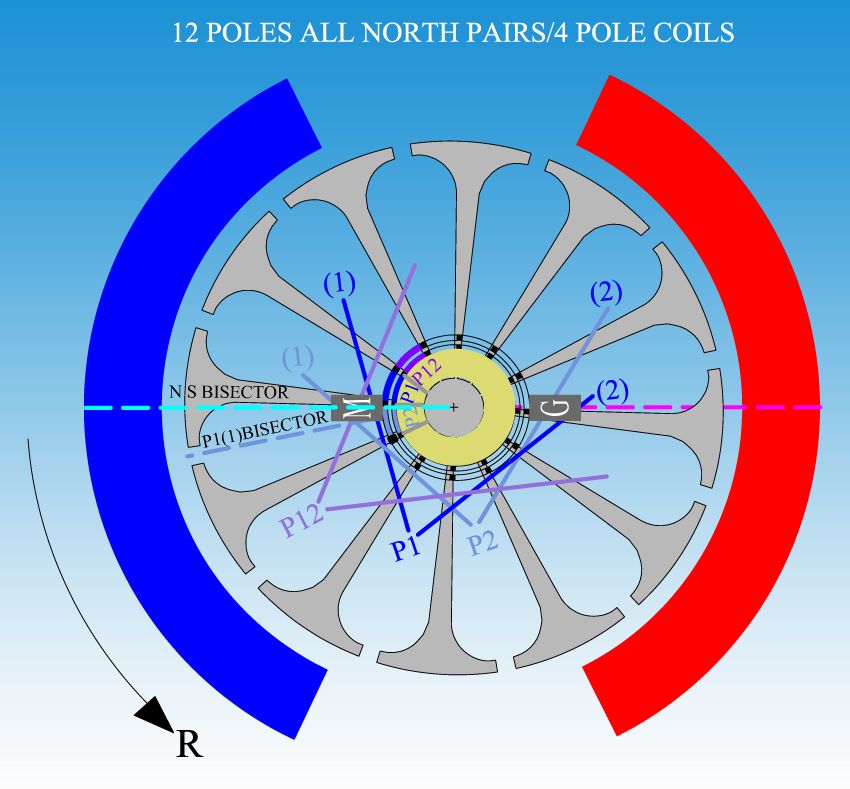Originally posted by GChilders
View Post
@all
The most important lesson that I have learned this week in the Battle of the Windings is how critical the timing is to all of the asymmetrical type of motors. In every case 5 degrees of timing can radically change the performance of the motors. I come from the background of automotive technology and have always known that timing is so critical in an automobile engine. I never thought that it would be so critical in an electric motor. I have been testing and retesting the timings on these machines all week and have found the results almost unbelievable as to the differences that it makes. The one advantage that my replications have over most that I have seen is that I can retard the timing up to 10 degrees and in most of my embodiments advance it up to 10 degrees. The exception being my first embodiment in which I can only get about 5 degrees advance. When the sweet spot is found the amps in plummet like a rock. You will see this when I release the videos upon completion of all of the timing tests. This is the second time that I am working through the tests. I made an error in the first run because of my unfamiliarity with the clamp ammeter. I noticed on some of the tests the ammeter was retaining a reading and not zeroing out before the test. I reread the manual and there is a button for relative (rel) on the meter that zeros out the reading. This brought down the amp readings on all of the timing tests. When you see how the all north performs against the stock gold mine motor you will be amazed. In the second timing test the amps drop from 850 milliamps to 110 milliamps!!!! The RPM dropped to slightly above 8300 rpm. This compared to the retested stock motor which came in slightly above 3600 rpm at right around 300 milliamps. And still maintained good torque features. I cannot think of a good measuring device for the torque of these motors. The shafts are only 4 millimeters in diameter and won't hold much in vibration without bending. You can take my word that in the grab test they do just fine. Now this is at 12 volts. Way below the maximum voltage for the stock motor and who knows what the maximum voltage of the redesigned motor will be. 1/3 of the amperage in and over double the RPM and still has respectable torque. The question that needs to be answered is how have you handled the timing of the motor??!! If you are having high amp readings I challenge you to make an embodiment like I have to be able to experiment with the timing. These motors are still in the experimental stages and need to be thoroughly tested in various timings. The results will astound you!!!!
Cheers
Garry
The most important lesson that I have learned this week in the Battle of the Windings is how critical the timing is to all of the asymmetrical type of motors. In every case 5 degrees of timing can radically change the performance of the motors. I come from the background of automotive technology and have always known that timing is so critical in an automobile engine. I never thought that it would be so critical in an electric motor. I have been testing and retesting the timings on these machines all week and have found the results almost unbelievable as to the differences that it makes. The one advantage that my replications have over most that I have seen is that I can retard the timing up to 10 degrees and in most of my embodiments advance it up to 10 degrees. The exception being my first embodiment in which I can only get about 5 degrees advance. When the sweet spot is found the amps in plummet like a rock. You will see this when I release the videos upon completion of all of the timing tests. This is the second time that I am working through the tests. I made an error in the first run because of my unfamiliarity with the clamp ammeter. I noticed on some of the tests the ammeter was retaining a reading and not zeroing out before the test. I reread the manual and there is a button for relative (rel) on the meter that zeros out the reading. This brought down the amp readings on all of the timing tests. When you see how the all north performs against the stock gold mine motor you will be amazed. In the second timing test the amps drop from 850 milliamps to 110 milliamps!!!! The RPM dropped to slightly above 8300 rpm. This compared to the retested stock motor which came in slightly above 3600 rpm at right around 300 milliamps. And still maintained good torque features. I cannot think of a good measuring device for the torque of these motors. The shafts are only 4 millimeters in diameter and won't hold much in vibration without bending. You can take my word that in the grab test they do just fine. Now this is at 12 volts. Way below the maximum voltage for the stock motor and who knows what the maximum voltage of the redesigned motor will be. 1/3 of the amperage in and over double the RPM and still has respectable torque. The question that needs to be answered is how have you handled the timing of the motor??!! If you are having high amp readings I challenge you to make an embodiment like I have to be able to experiment with the timing. These motors are still in the experimental stages and need to be thoroughly tested in various timings. The results will astound you!!!!
Cheers
Garry
Excellent!!!! That right! It's all about the timming people!





Comment